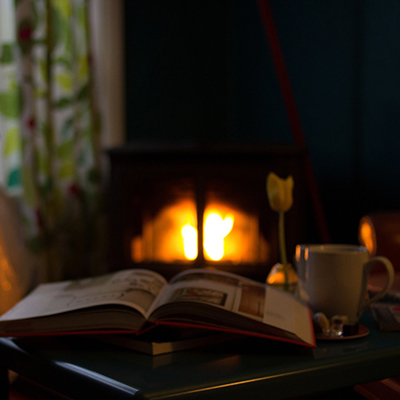 Watching the flames as you burn logs in your fireplace might be one of your favorite things to do in winter but it’s very dangerous if there is too much creosote in the chimney flue.
Watching the flames as you burn logs in your fireplace might be one of your favorite things to do in winter but it’s very dangerous if there is too much creosote in the chimney flue.
The leading cause of home fires associated with fireplaces and chimneys is highly flammable creosote buildup, according to the National Fire Protection Association (NFPA).
Creosote in the chimney can’t be prevented entirely, since the combustion gases from every wood fire leave some creosote deposits behind. It’s possible, however, for you to greatly minimize the buildup and chimney care experts can help.
What is Creosote?
Creosote is a tar-like deposit in chimney flues from toxic combustion gases and particulate matter created in a wood fire. The concentrated makeup of the gas depends on the type of wood being burned and the amount of moisture in the wood. The only logs that should be burned in a fireplace are seasoned, which means they have low moisture content. If green or unseasoned wood is burned, a much greater volume of harmful smoke is released plus the fire is far less efficient.
As creosote coats the inside of the flue, the chimney passageway through which smoke is supposed to exit narrows. This causes an obstruction, which further restricts ventilation.
Tips to Reduce Creosote in your Flue
What to Burn
Burning seasoned wood, the correct type of firewood, is important; and it’s the best way to minimize creosote deposits. Cut logs for a fire should be stacked in a way that leaves space for air at the bottom and on the different rows of firewood. Keep the logs protected from rain, whether with a roof over the wood or a tarp. It usually takes between 6 months and a year for logs to be seasoned.
Fires built with seasoned firewood burn clean enough that creosote deposits are kept to a minimum. Unseasoned logs, on the other hand, quickly add to the highly flammable buildup in your flue.
Artificial logs are similar to green wood because they also leave a bigger mess in your flue because of excessive combustion gases.
Types of Fires to Maintain
Another way to reduce creosote deposits is to avoid smoldering, slow-burning fires. Burn hot fires, which are efficient and emit fewer toxic combustion gases.
Prime the Flue
Before starting a fire, light a match and then blow it out, to see where the smoke goes. If it doesn’t escape up the chimney, the flue may need to be primed. What’s likely happening is that there is a cold column of air in the flue preventing smoke from rising. Priming the flue is usually done by holding a lit, rolled-up newspaper torch near the open damper. Repeat a time or two, as needed, to get rid of the cold air and allow the chimney to function properly.
 How Chimney Professionals Can Help Reduce Creosote
How Chimney Professionals Can Help Reduce Creosote
The NFPA and other fire experts recommend having your chimney inspected every year. During an inspection, chimney sweeps check the flue and let you know how much creosote buildup there is. Chimney experts can also use their tools of the trade to clean your chimney and remove creosote. According to the Chimney Safety Institute of America (CSIA), the flue should be cleaned anytime the layer of creosote buildup has reached at least 1/8”.
Contact the Experts at Chimney Solutions
The best help with chimneys and fireplaces that you can get in the Indianapolis, Indiana, area is at Chimney Solutions. Our chimney professionals are all CSIA-certified and NFI-certified, and they can help you avoid a hazardous chimney fire by removing creosote. Contact Chimney Solutions today by calling 317-757-6979.
